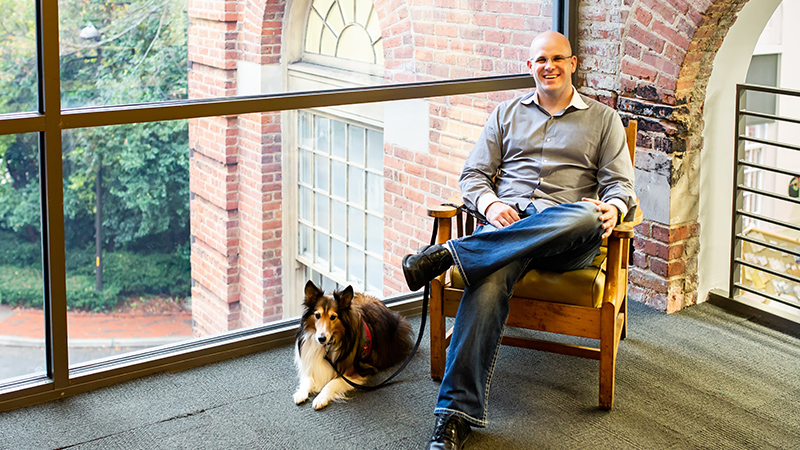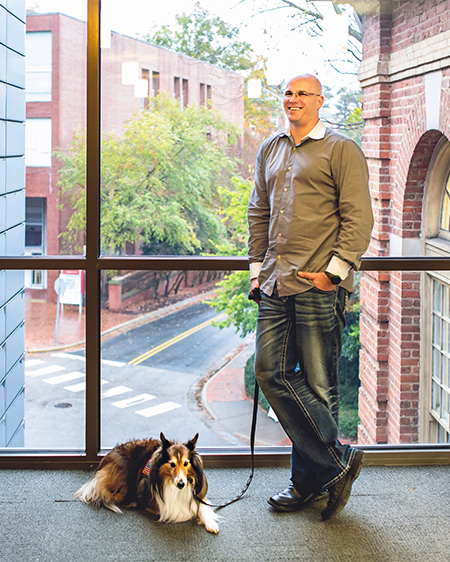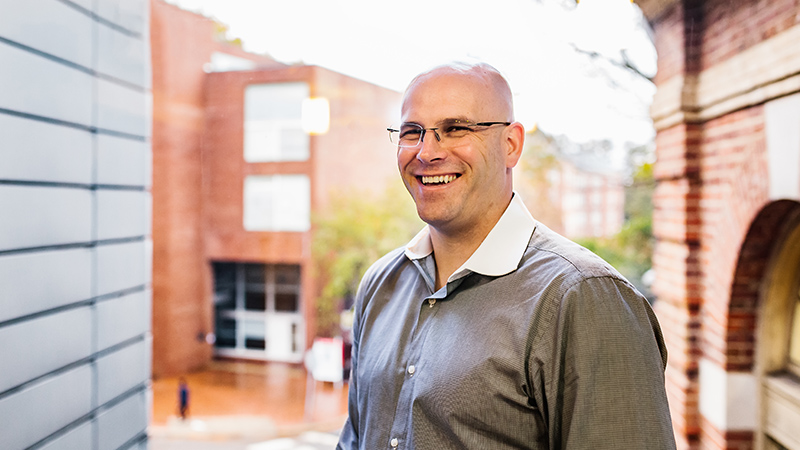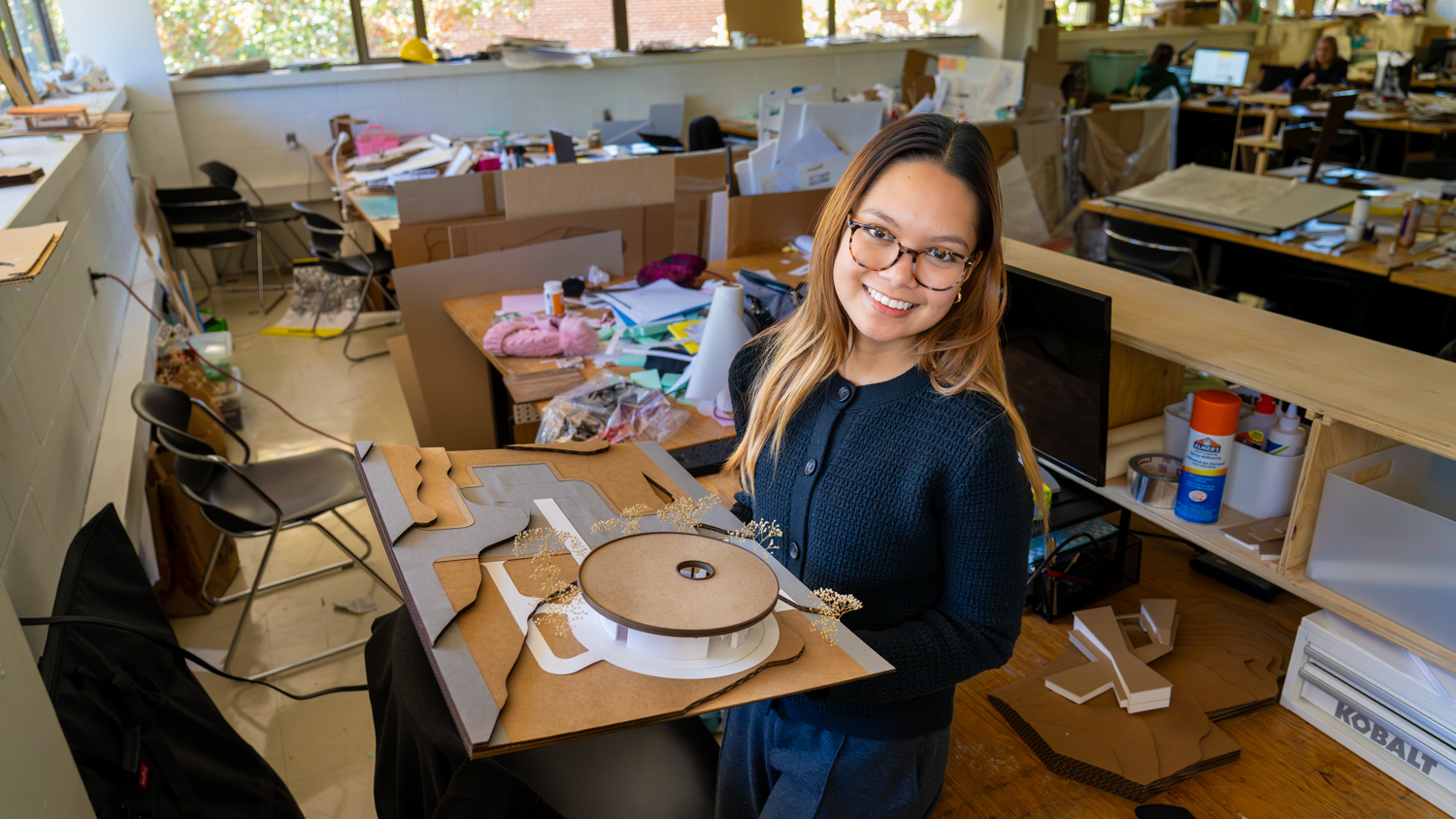From Air Force to Architecture: Veteran Sees Opportunities in Design

Dustin Sicard, a veteran and track 3 architecture graduate student in his final year at NC State, was recently honored alongside other NC State veterans and current military members at the annual military appreciation football game. Sicard is part of a small group of veterans enrolled in the College of Design.
Sicard and I met for the first time on a cold, rainy November day. As we talked over how he came to be at the College, Sicard’s service dog, Gizmo slept at our feet. “She seems pretty chill,” I say. “Yeah,” Sicard says, “everywhere we go, she has a calming effect… she brings a lot of happiness to people.”
Sicard tells me that he joined the Air Force after speaking with a family friend who was an active member of the Army National Guard. He also visited recruiters and considered everything he wanted to do in the next stage of his life. “I wanted to have fun, I wanted to travel, and I wanted to get paid to do it. And there’s the patriot part of it—you’re doing a civic duty.” The Air Force, as opposed to other branches of the military, checked all the boxes for Sicard. He says the moment felt like “doors of opportunity were being open,” which is something he continues to look for today.
“Even though there’s a lot of ups and downs in the military, I’m so thankful that I did it. It’s brought me so many good things. And heartaches too sometimes, but that’s ok.”
While in the military, Sicard worked primarily in the medical field. He served as an aeromedical flight medic in Iraq and also worked in the largest military hospital since the Vietnam War. “Even though there’s a lot of ups and downs in the military, I’m so thankful that I did it. It’s brought me so many good things. And heartaches too sometimes, but that’s ok.”

“How do you handle that?” I ask. “You just, you have to evolve,” Sicard says. But he also says, “when I look back, I can name names of people in Iraq and throughout my service in the military who were like ‘come here, this is my wing, you’re going to stay here.’ And then you walk away and you know that’s the way to be and that’s what you need to do for somebody else along the way.”
After 15 years in the military, Sicard was considering physician assistant school. Realizing that he enjoyed the preventative side of medicine but was frustrated with other aspects of it, he began working with a life and wellness coach. Sicard took personality and strength tests and saw that “everything lined up in architecture but not in medicine.” Because of the time commitment necessary in the military and in graduate school, Sicard knew that he couldn’t do both simultaneously. “I knew coming into architecture that I was going to get out of the military… I just wanted to give all my attention to architecture.”
With a bachelor’s degree in sociology and a medical military career, Sicard did not have an art background to pull from for his application portfolio. So, before even applying to NC State, Sicard moved to North Carolina and took art classes at the University of North Carolina Wilmington and Cape Fear Community College. While there, he pushed the boundaries of sculpture—“One of the things I did was build my own furnace. I cast aluminum through wood, and I explored how that worked. And nobody was really doing much of that kind of sculpting, and it’s not easy.”
…Now I have the opportunity to influence the spaces and places people occupy in a positive, healthy way.”
Although it seemed like an abrupt change from medicine to architecture, it really wasn’t that big of a leap. In many ways, Sicard says he is continuing his core value of helping people live better lives. In the military, he says, “people’s lives were in my hands, directly in my hands,” and with architecture, “they’re still in my hands… if I don’t make sure the structure is right or do the things I’m supposed to do, people could die. Now I have the opportunity to influence the spaces and places people occupy in a positive, healthy way.”
The architecture program is demanding—“Here they push you. You know, and I like that,” Sicard says, but he’s looking forward to the semester break to reflect and consider his next move and his long-term future. What is clear from our discussion, though, is that Sicard sees architecture as a tool to improve lives, and he wants his work to exemplify this philosophy. “I’m interested in residential. I’m interested in commercial as well. I don’t want to just do one thing necessarily.”
The career flexibility is part of what attracted Sicard to architecture. “In architecture, there are many doors of opportunity. I don’t have to go and be an architect directly, I could go and be a shoe designer… I could end up working for Boeing or BMW as a designer. What matters when you’re going through this program is learning how to be creative, how to design, and how to think about design. And I love it. I love that it’s about space and place.”
Staci Kleinmaier is a professional writer and photographer in Apex, North Carolina. She uses words and images to tell stories. To see her work, visit www.stacikleinmaier.com.
- Categories:



